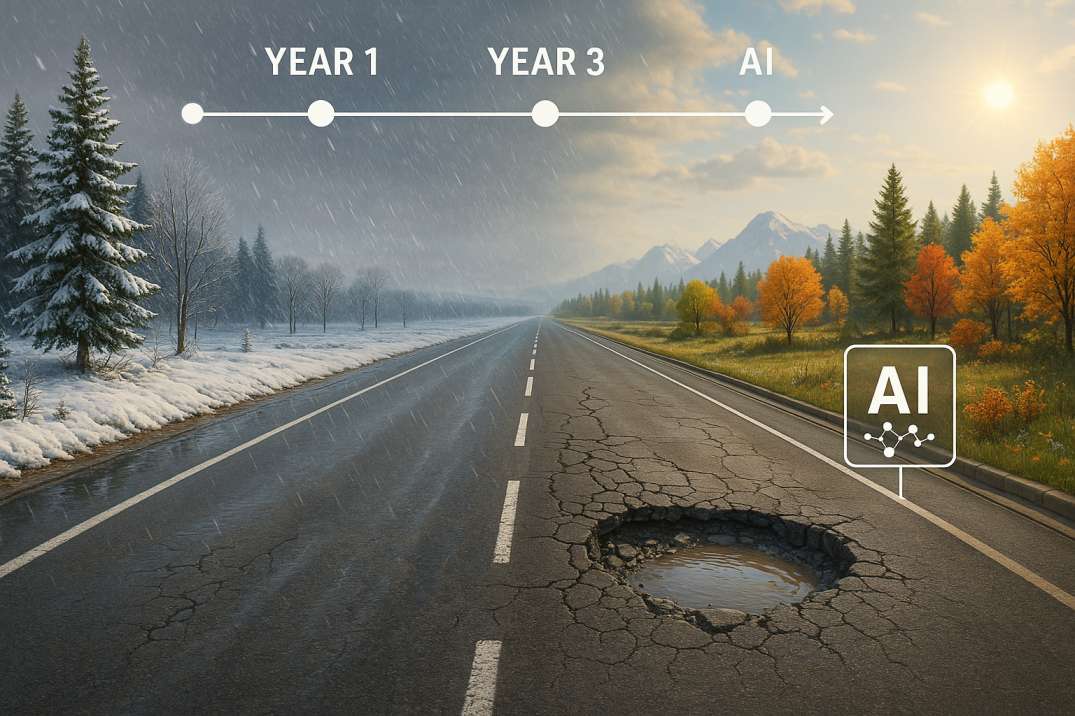Contact Us
RoadVision AI
Private Limited
Office No. 308 & 310, B Block
Ansal Chamber - 1, Bhikaji Cama Place,
Near Engineers India Limited (EIL) Bhawan, New Delhi - 110066
© 2024 | RoadVision AI | All rights reserved
Canada's vast road network is a lifeline for its economy and connectivity. With over 1.04 million kilometres of public roads, maintaining road infrastructure is both a logistical and financial challenge. Harsh climates, freeze-thaw cycles, and increasing traffic loads significantly accelerate pavement deterioration across the country. Traditional methods of road inspection and maintenance are no longer sufficient. Canada needs AI-powered pavement deterioration prediction models to shift from reactive fixes to predictive maintenance, improving both efficiency and road safety.

According to Transport Canada and various provincial infrastructure reports, a significant portion of Canadian roads are aging, with maintenance backlogs and limited public funding. Most municipal and provincial transportation departments still rely on periodic manual inspections to assess road conditions. This approach is not only time-consuming and labour-intensive but also prone to subjectivity and delayed interventions.
Road asset management Canada demands a more advanced solution—one that leverages data, machine learning, and real-time analytics. That solution lies in AI-driven pavement deterioration models.
Pavement deterioration prediction models use historical and real-time data to forecast the future condition of road surfaces. Traditional models use empirical data and statistical regression, but these are often limited by regional variations, weather patterns, and pavement types. AI-based models overcome these limitations by learning from diverse datasets, adapting to changing patterns, and predicting outcomes with much higher accuracy.
Canada's road maintenance programs often operate reactively, fixing roads after significant deterioration has occurred. This results in:
Considering Canada's challenging climate, pavement condition monitoring must be proactive. AI provides that capability.
AI algorithms analyze vast datasets from road sensors, satellite imagery, LIDAR scans, and pavement condition surveys to predict when and where roads will deteriorate. By doing so, agencies can prioritize repairs based on risk, optimize budgets, and extend the life of road infrastructure.
Incorporating AI into road asset management Canada means transitioning to a system that anticipates issues before they occur. For example, an AI model can forecast pothole formation based on seasonal weather forecasts and traffic volume trends, enabling targeted preventive maintenance.
The Transportation Association of Canada (TAC) has advocated for data-driven approaches to pavement design and maintenance. Its guidelines encourage integrating modern technologies like AI, remote sensing, and geospatial analysis for improved decision-making.
Provinces like Ontario and British Columbia have also begun exploring AI for infrastructure planning, creating opportunities for public-private partnerships and pilot programs.
Roadvision AI is at the forefront of modernizing infrastructure with its suite of intelligent road inspection solutions. Its technologies combine AI, computer vision, and IoT to offer:
These services ensure that municipalities and provinces get actionable insights into road health, enabling data-driven decisions.
Explore their industry knowledge hub here: Roadvision AI Blog or see their case studies for real-world impact.
To keep pace with increasing demands, road infrastructure management must evolve. AI is not a luxury—it is a necessity. With the power of pavement deterioration AI, Canada can:
Investing in AI-powered pavement deterioration prediction models is no longer optional for Canada. It is the foundation for smarter, safer, and more sustainable infrastructure. Government agencies, municipalities, and infrastructure firms must adopt these technologies to future-proof the nation's roadways.
RoadVision AI is revolutionizing roads and transforming infrastructure development and maintenance with its innovative solutions in AI in roads. By leveraging Artificial Intelligence, digital twin technology, and advanced computer vision, the platform conducts thorough road safety audits, ensuring the early detection of potholes and other surface issues for timely repairs and improved road conditions. The integration of potholes detection and data-driven insights through AI also enhances traffic surveys, addressing congestion and optimizing road usage.
Focused on creating smarter roads, RoadVision AI ensures compliance with IRC Codes and Canadian road regulations, empowering engineers and stakeholders to reduce costs, minimize risks, and elevate road safety and transportation efficiency.
Book a demo with us to see how Roadvision AI can transform your road maintenance strategy.
Q1. How does AI predict pavement deterioration?
AI uses data from sensors, weather, traffic, and past road performance to forecast future damage with high precision.
Q2. Is AI-based maintenance cost-effective for small municipalities?
Yes, predictive maintenance reduces long-term costs and helps even smaller towns better manage tight budgets.
Q3. What data is needed for AI road models to work?
Key inputs include road condition imagery, traffic data, climate patterns, and material specifications.